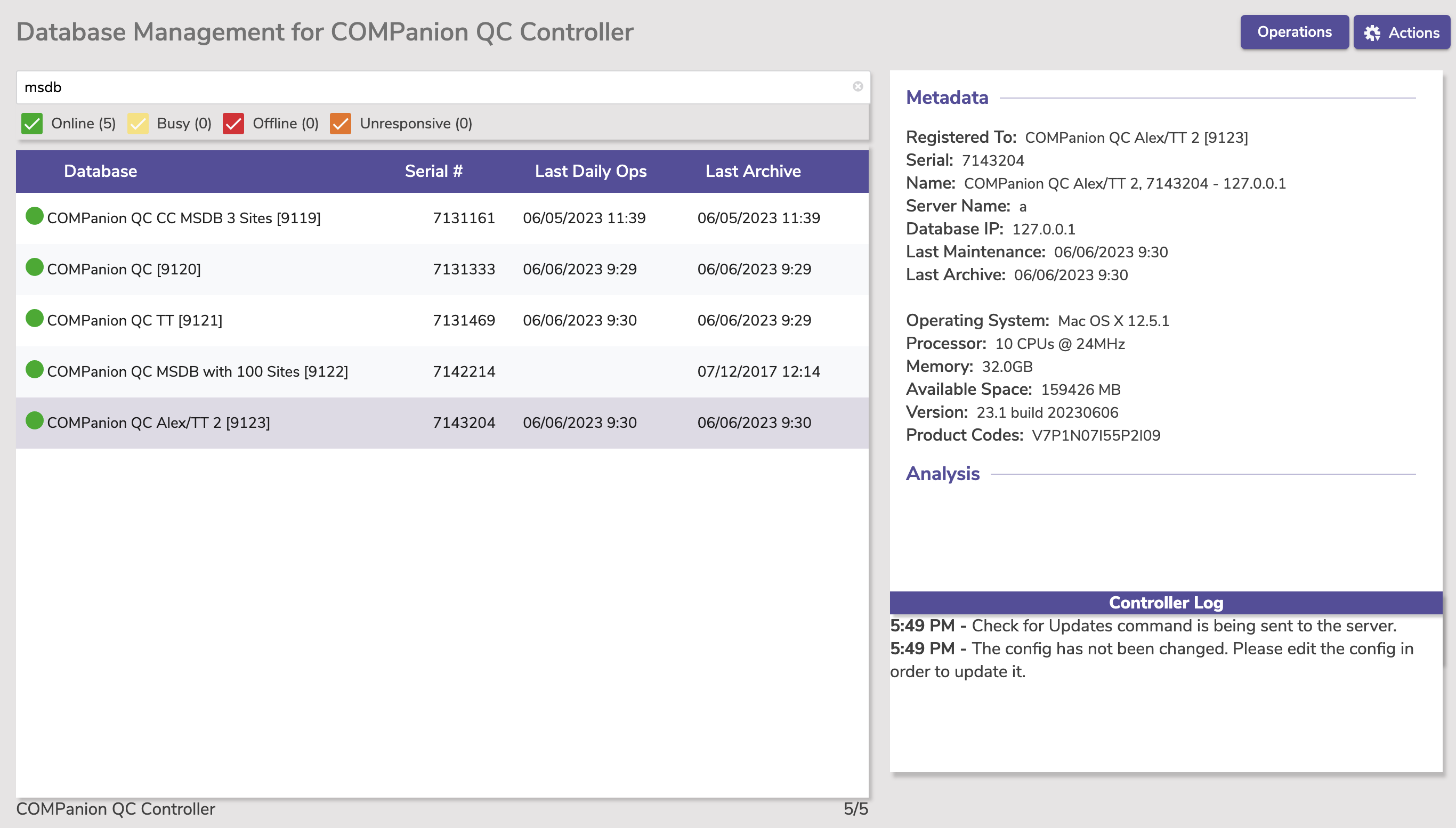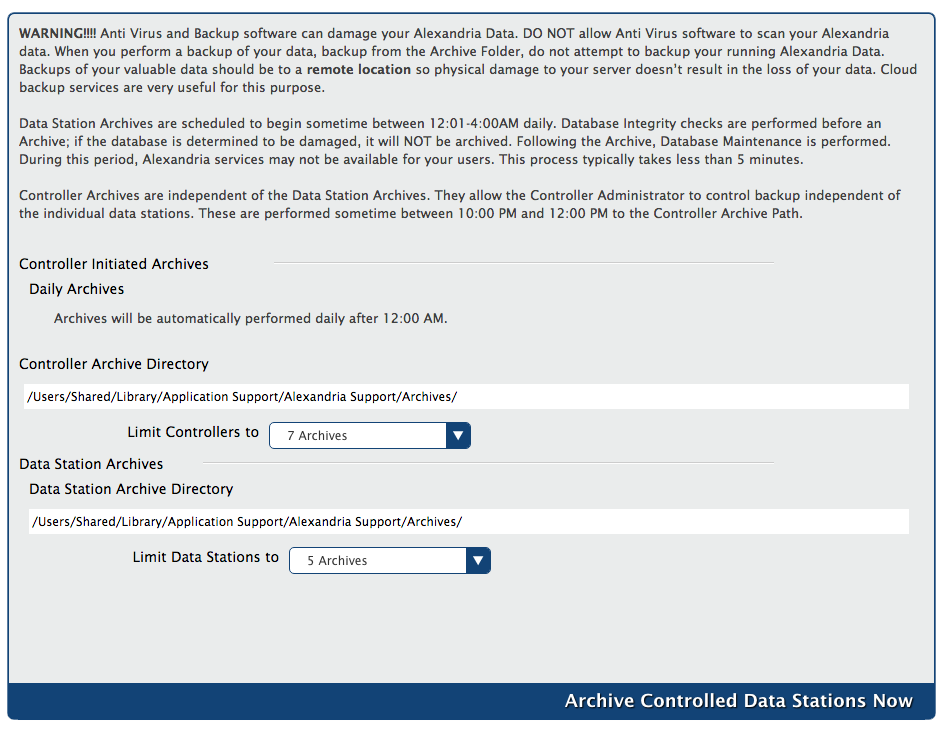- Created by user-1631c, last modified by Bethany Brown on Jun 21, 2023
You are viewing an old version of this page. View the current version.
Compare with Current View Page History
« Previous Version 120 Next »
Administration
How helpful was this page?
Controller Administration Settings
Although you are allowed to make changes to individual Preferences for every site your Alexandria Controller maintains—the actual Controller Data Station also contains some limited, globally-based settings of its own.
The Administration settings are high-level preferences intended for network administrators or IT Technology Support departments; in other words, advanced settings that ordinary operators wouldn't be able to configure without help. These settings are used to configure your Controller Data Station (i.e. server) email information, archive schedules, database maintenance, web settings, and system updates.

These Database settings only appear for those running a Centralized Catalog, Distributed Catalog, or an independently operated Data Station in a Distributed Catalog. Data Station Administration settings apply to all sites and contain configurable settings for the entire union.
 Database
Database
These settings allow you to configure the location where local archives are stored. It is where you will also perform manual archives for your Data Stations.
Archiving is an automatic method of making complete, regular copies of your database and storing them in a designated folder on your hard drive. Manual archives should be performed before making any large-scale changes to your database, such as imports, updates, utilities, or machine upgrades. Your most recent archives are handy when trying to fix a bad import and are invaluable in securing the safety of your data. However, archives are not backups; the major difference between a backup and an archive is that backups are made on removable media and physically stored offsite (or in the cloud). Since archives are entirely useless in the event of a hard drive failure, keeping an offsite or cloud backup is highly recommended!
Database maintenance examines your database files and indexes and then performs patron, item, and circulation verification routines. If database damage is detected, it's automatically fixed. The maintenance should be performed at least once a month to keep your data in good, working order.
The Controller will automatically archive the data folder for each of your data sets between 12:01 and 4:00 a.m. daily. It will archive the Controller data folder between 10:00 p.m. and 12:00 p.m. During an archive, all other Data Station operations are temporarily suspended.

Settings
Archive Directory
By default, archives are stored in folder within the Alexandria Support folder. However, we highly recommend that you change the location to a one outside of the Alexandria Support folder, preferably on a separate drive. You can set a custom location for your Archive Directory in Administration > Database. If you enter an invalid folder, or if it becomes invalid for any reason (such as disconnecting the drive it's on), it will automatically be replaced with the default folder.
We control the folder structure within your Archive Directory. Within the Archive folder is a subfolder for each of your database serial numbers, in which individual archives are stored. Archives are titled by the date and time in the YYYYMMDD HHMMSS format. Daily archives include "DAILY" in the title; Snapshot archives do not.
Archives > Serial Number > Archive YYYYMMDD HHMMSS
Archives > 8888001 > Archive 20180720 110704 DAILY
Storage Limits
Here, you can choose how many Daily Archives and Snapshot Archives to store at a time, up to 14 of each. Just make sure you have enough free space for them all! If you begin to run out of space, or if you're already storing more than the number you specified, the oldest archive of the type being run will be removed.
We strongly advise you to review these settings regularly to ensure that your archive directory is up to date and the number of archives stored is properly configured based on your needs and available disk space.
Monitor
The monitor interface gives you access to vital Controller capabilities and settings anywhere around the world; the ability to remotely start or stop controlled Data Stations proves invaluable in times of crisis.
This is where you add, remove, start, stop, restart, rebuild, archive, and configure all of your controlled Data Stations. The monitor interface can be easily broken down into two diverse sections:
- The top portion is comprised of your managed Data Stations; listed is their current status, serial number/host name, and most recent maintenance.
- The bottom section contains the Controller Log.
Settings
The top of the monitor interface is comprised of a list of managed Data Stations which can not be rearranged or re-ordered. This list contains information about which Data Stations are active or stopped, their names, serial numbers, IP address, and port numbers.
The Search box at the top-right allows you to quickly isolate a Data Station from the list. Start typing information into the field (e.g. Data Station/PID or Serial/Host Name) and the managed Data Station that most closely matches your criteria will remain. This makes it easy to quickly locate a managed Data Station.
Use the Running, Busy, Unresponsive, and Stopped filters to only show (or hide) Data Stations with corresponding statuses. If there are no Data Stations with matching statuses, the full list will be displayed.

The selections contained in the Actions menu of the monitor interface can be used in conjunction with selected (highlighted) Data Stations; for example, you can Start Selected (currently inactive) or Stop Selected (currently active) Data Stations.
Actions Menu
Allows you to perform a number of useful functions and operations, including modifying managed Data Station's Administration settings (e.g. configure email, set web options, etc.), Add or Remove a Data Station, assign a time zone, or perform an archive or rebuild on a selected Data folder.
- Edit Configuration File. Allows you to edit the selected Data Station's “Configuration.txt” file to update your registration information. When a Data Station is newly added to the list, it preserves the Controller's default settings; use the Edit Configuration command to customize them.
- Start Selected. If you would like to manually start a selected, disabled Data Station, select Start Selected.

- Stop Selected. If you would like to manually stop a selected, active Data Station, select Stop Selected.
- Add. You may also click on the Add button, causing a message window to appear. You will be given a choice to Add a new Data folder or Create a new one. If you wish to do neither, click Cancel. For more information on importing or creating new Data Stations, please review Adding New / Existing Data Stations.
- Remove. If you wish, you may also choose to Remove a selected (i.e. highlighted) Data Station from the management list. Use caution before removing a Data Station; the entire Alexandria Support folder (including your Data folders) will be permanently deleted. This cannot be undone. Removing a Data Station will also remove all of its data and support files. This can not be undone!
- Maintenance for Selected. This examines your selected Data Station's database files then performs Patron, Item, and Circulation validation routine. If database damage is detected, it will be recorded in the server log.
- Archive Selected. This performs an immediate, manual archive of the selected Data Station's database; manual archives should be performed before making any large-scale changes to your database, such as imports, updates, or utilities. During an archive, all information in the Data Station's Data folder is copied into the Archive Directory you've configured. Additionally, all services on the Data Station are temporarily disabled.
- Restart Selected. This allows you to restart the selected Data Station from the list. During the restart duration, Alexandria services, interfaces, and modules will be unavailable to all patrons and operators. Essentially, this is a stop and start routine contained in a single, convenient selection.
- Set Data Station's Time Zone. The ability to control remote collections from around the world using a single IP address requires precise time zone settings. For example, if your Controller runs under pacific daylight time (PDE) and you're hosting a Data Station on the east coast (EST), setting the correct time zones for this client will ensure that transactions and other time stamps are recorded to the database at the time they occurred for the Data Station, not for the Controller.
Show Data Station Administration. Opens the Administration interface for Controlled Data Stations in a new browser window. Controlled Data Stations have fewer Administration settings, lacking both Web and Database tabs.
The Controller Log
The bottom half of the monitor interface contain the Controller's log. This log captures and stores all pertinent Controller information, including when each Data Station is stopped or started, and any special operations (e.g. archive or rebuild) that have been initiated or performed. While in this section, you may select Print from the File menu to print the log. The controller log is automatically saved by the Controller. Logs are saved inside the Log folder, located in the Alexandria Controller Support program directory.

Activate Alexandria Data Stations on the Controller
The Alexandria Controller has the ability to Start and Stop Selected Data Stations that it manages. When you Add a new or existing Data Station, they will initially appear as Stopped in the monitor list.

- Select the Data Station(s) you would like to activate from the list and choose Start Selected from the Actions menu.

- You can activate more than one Data Station at a time. When Alexandria Controller is shut down and restarted, all of the individual Data Stations automatically activate. If a Data Stations fails to auto-start on launch, an “unable to start” error message will be recorded to the log. The green Running box located in the Status column of the managed list indicates the Data Station is active.

At this point, activated Data Stations are broadcasting—awaiting connections on their default Port ID.
The only person able to access the Controller's Administration settings is the Admin operator defined in the Settings tab; this operator is not a standard patron and can not be modified in Patrons Management. COMPanion will have emailed you the Admin Username and Password required to access Controller Administration; your access and registration information can also be found on the back of your Getting Started Guide. If you still can't locate your login information, contact our support at Customer Support at (800) 347-4942 or by email via: support@companioncorp.com. If needed, you can also use the Can't access your account? link during Login to reset the Controller's Admin Username and Password.
 Email
Email
![]() /admin > Email
/admin > Email
The information on this page may be outdated. SEE Email Preferences
To send email reminders, such as the Overdue Items Notice, you will need to configure how Alexandria communicates with your library's email server. Alexandria's email system is designed to potentially cope with hundreds of emails being sent (or resent) over many machines at the same time.
What happens if an email fails to send?
If a send fails, the next resend time is generated by adding a random value between 3 and 9 minutes, spreading out the resend times so all the undelivered email still in the “short range” period isn't sent at the same time. If a send hasn't succeeded by the end of the “short range” period, the program will generate new send times using random values between 60 and 90 minutes. If a send still hasn't succeeded after 100 hours the email is discarded and a “return-to-sender” email will be sent.
For emails to work, you will also need to...
- Add a valid email address to your site record.
- Add a valid email address to at least one operator record.
Settings
Use the Email settings to configure how Alexandria communicates with your library's email server.

The Server 1 and Server 2 sections are used for outbound email. Server 1 is the primary server and Server 2 can function as a back up server should server 1 fail. You only need one SMTP server to use the email functionality. For networks with a single SMTP server, configure the setting in the Server 1 section.
- SMTP Server 1 and 2. This is the TCP/IP or DNS address of your library's mail server, which is usually mail.yourdomain.com.
- Port. Enter the port number used by the outgoing mail server. Common ports for outgoing mail include 25, 465, and 587.
- Allow Non-Secure Connections. Alexandria uses Transport Layer Security (TLS) for secure web communications. When this setting is enabled, the system will use non-TLS connections if it cannot make an TLS connection.
- Some mail servers, including Office365, do not allow you to use non-secure connections.
- Login. Enter the login for your email server.
- Password. Enter the password for your email server.
- Test Server. Test the SMTP Server settings by sending a test email. This email is sent to the email address listed in the Sites module.
- Last Tested On. This field displays the last date/time that the server test was performed.
- Last Test Results. This field displays whether the test was successful or not. If the test is unsuccessful, check your SMTP server address and try using a different port.
Set Up Your SMTP Server
Use Gmail As Your SMTP Server
A Gmail account can be used as a portable SMTP server if your library's network does not already have one. Before you configure Alexandria to use Gmail, you need to set your Gmail preferences to Allow Less Secure Apps*.
- Go to /admin > Email.
- Enter the following settings for Server 1:
- SMTP Server Address: smtp.gmail.com
- Port: 587
- Login: Enter the username for your email server.
- Password: Enter the password for your email server.
- Click Save in the upper-right corner of the window.
- Click Test Server, to ensure the Gmail account is acting as a server.
- Repeat for Server 2 (optional).
*End of May 2022, Google will not let you choose to 'allow less secure apps'. See this article. At the moment, the COMPanion Support Team is recommending that you make use of an SMTP relay service. Read more: What is SMTP relay? | SMTP relay: Route outgoing non-Gmail messages through Google.
Settings
These settings allow you to configure the Controller to operate in your native language.
The Show Available Data Stations list allows users to pick a Data Station from a list when just the Controller's URL is entered. The Controller name is use by the Monitor interface. The Admin Email Address is used to notify the administrator when administrative operations are performed on the Controller.

Settings
- Language. The language selected here will be the default for the Controller; you may choose from one of our currently supported languages: English, Spanish (Español), or French (Français). Changing the default language requires a browser refresh to take effect on the web.
- Show Available Data Stations. If no serial number is specified in the URL when a web client connects, this preference shows a list of available sites to pick from; if disabled for security purposes, you can show the user an error indicating that no such page exists.
- Controller Name. Enter the name of your Alexandria Controller; the default is your district name.
- Admin Email Address. This is the Controller Admin operator's email address, which is used as the return mail address for notices and other email messages sent by Alexandria. To guarantee that your email notifications are being sent, please check the list of requirements located under your Email settings. You must enter a valid email address to use most email services, including COMPanion's Customer Support services.
- Admin Username. This is the Username of your Alexandria Controller Administrator.
- Change Password. Select this option to change the current password for logging into the Controller.
Error rendering macro 'include-content'
Couldn't find page: Controller Settings
Error rendering macro 'include-content'
Couldn't find page: Controller Web Settings

